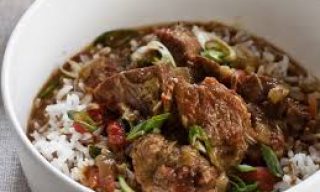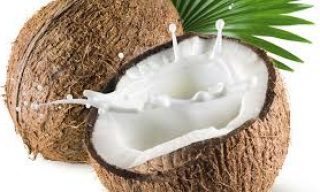While the coconut is a mainstay in the diet of nearly one-third of the planet, it’s considered exotic in the Western world. Experts
describe the coconut as not just a fruit, but a nut and a seed as well – a drupe. It has three layers: the outside layer is known as the exocarp, and the fibrous husk or mesocarp is inside of it. The thin, woody layer surrounding the actual coconut “meat” is the endocarp.
Since man inhabited the world, coconut trees were in existence. Coconuts have been used not only to produce fiber, fuel, and even musical instruments, but also as a traditional Asian and Pacific Island folk remedy.
For centuries, the coconut has been claimed as a potent cure for nausea, rash, fever, earache, sore throat, bronchitis, kidney stones, ulcers, asthma, syphilis, dropsy, toothache, bruises, and lice. And that’s just the short list. While coconut milk is a wonderful base for all kinds of Thai dishes, coconut oil is becoming increasingly used in the U.S. for its nutritional benefits.

Health Benefits of Coconuts
Modern medicine has also found coconuts nutritionally beneficial because:
- They’re loaded with naturally sterile electrolytes, which feed your pH and muscle function
- They have a high fiber content, which makes you feel full longer and helps regulate elimination
- They’re rich in lauric acid, which converts to monolaurin. Monolaurin is the compound found in breast milk that strengthens a baby’s immunity, and a great deal of research has been done to establish the ability of lauric acid to enhance immunity. This medium-chain fatty acid (MCFA) actually disrupts the lipid membranes of offending organisms.
- They offer high levels of manganese, potassium, and phosphorus.
| Amt. Per Serving |
% Daily Value* |
|
|---|---|---|
| Calories | 345 | |
| Calories from Fat | 280 | |
| Total Fat | 33 g | 52% |
| Saturated Fat | 30 g | 148% |
| Trans Fat | ||
| Cholesterol | 0 mg | 0% |
| Sodium | 20 mg | 1% |
| Total Carbohydrates | 15 g | 5% |
| Dietary Fiber | 9 g | 36% |
| Sugar | 6 g | |
| Protein | 3 g | |
| Vitamin A 0% | Vitamin C | 5% |
| Calcium 1% | Iron | 13% |
*Percent Daily Values are based on a 2,000 calorie diet. Your daily values may be higher or lower depending on your calorie needs.
Studies Done on Coconuts
The fats and oils in coconuts are, like those derived from other sources, made up of molecules called fatty acids. There are two ways to classify fatty acids; one involves saturation, i.e. saturated, monounsaturated, and polyunsaturated fats. The other is based on molecular size or the length of the carbon chain.
Each fatty acid consists of long chains of carbon atoms with hydrogen atoms attached – short-chain fatty acids (SCFA), medium-chain fatty acids (MCFA), and long-chain fatty acids (LCFA).
Coconut oil is composed predominately of medium-chain fatty acids (MCFA), or medium-chain triglycerides (MCT).1
Nearly 98% of the fats and oils in our diets are composed of LCFA. That’s significant, because the physiological effects of MCFA in coconut oil, which contains powerful anti-bacterial and anti-viral properties, are distinctly different from those of LCFA, which have a negative effect on your cholesterol levels. It’s rare, and the reason why coconut oil is so sought after. Its health benefits are as hard to beat as they are to explain!
In light of this information, one study comparing a medium-chained triglyceride (MCT)-based diet with a long-chain triglyceride (LCT)-based diet showed significant and positive results for HIV-infected patients suffering from chronic diarrhea, difficulty in absorbing nutrients, and subsequent weight loss.2
Coconut Healthy Recipes:
Thai Coconut Soup

|
Ingredients: |
||||
| 1½ cups water | 2 cups coconut water (see note below) | 2 cups young coconut meat | 1 cup fresh cherry tomatoes | ½ ripe avocado |
| 1½ clove garlic | 1 clove garlic | 2 clove garlic | 1 inch fresh ginger | 2 tablespoons white miso |
| 1 tablespoon flax seed oil | ½ teaspoon sea salt | 2 tablespoons nama shoyu* or wheat-free tamari soy sauce | 2 limes | 1/8 teaspoon cayenne |
| 1 stalk lemongrass, cut into 2 inch pieces | 1 carrot, sliced very thinly | 1 cup cilantro | 1/3 cup shallots chopped | |
Procedure:
- Blend all ingredients in a high-speed blender except for last four. Add the cilantro and blend briefly, so that you can still see small pieces of cilantro.
- Pour into a bowl and stir in last three ingredients.
This recipe makes four servings.
Note: You can find coconut water and coconut meat by breaking open young green coconuts (sold in some conventional grocery stores and Asian markets.) If you cannot find young coconuts, you can also use canned or bottled coconut water and canned coconut meat or three cups of canned coconut milk.
*Nama shoyu is a blend of raw shoyu (soy sauce) and can be found at health food stores.
(From Healthy Recipes for Your Nutritional Type by Dr. Mercola)
Coconut Fun Facts

“Coco,” meaning “monkey face,” was the name given to this tropical food by Spanish explorers because of the three indentations on the bottom. But these indentations are the key for opening the coconut successfully. Insert a screwdriver into the softest hole to drain the liquid into a bowl, and then use a sturdy knife to circumvent the coconut’s seam a few times. Give it a sharp “thwack” on a hard surface to break it into two pieces. Voilà!
Summary
As old as the dawn of time, man has made use of coconut’s hard casing, milk, and oil, which today has known health benefits that scientists are still exploring, such as omega-6 fatty acids, phytosterols, electrolytes, and manganese.
One of the coconut’s most important aspects is what its medium-chain fatty acids mean for the human diet. The good thing is that rather than the high-fat food it was once thought to be, coconut is a powerhouse of nutrition and healing.




